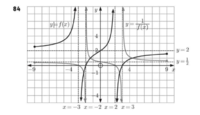DualDog321
New member
- Joined
- Jan 31, 2020
- Messages
- 9
Here is the question in my textbook that I am struggling with:

I have a worked solutions book for it too, and it shows as follows:

I am unsure of where the new asymptotes like x=3, x=-2, and y=1/2 came from.
For anyone wondering, this is Chapter 27, question #84, on pg 846 in the Haese Math HL Third Edition textbook.
Thanks.

I have a worked solutions book for it too, and it shows as follows:

I am unsure of where the new asymptotes like x=3, x=-2, and y=1/2 came from.
For anyone wondering, this is Chapter 27, question #84, on pg 846 in the Haese Math HL Third Edition textbook.
Thanks.

